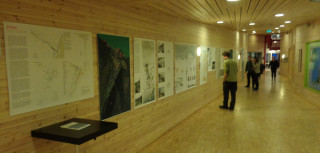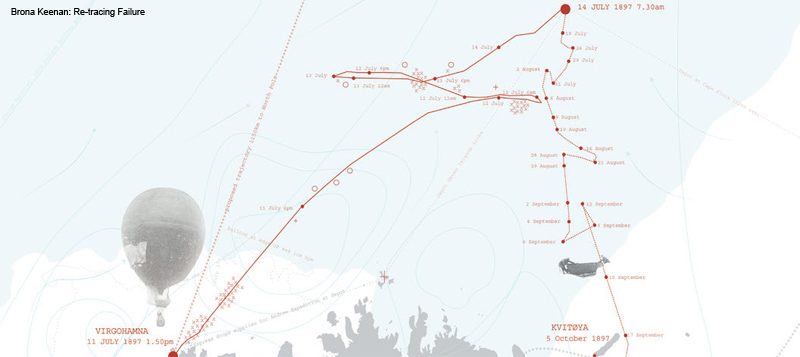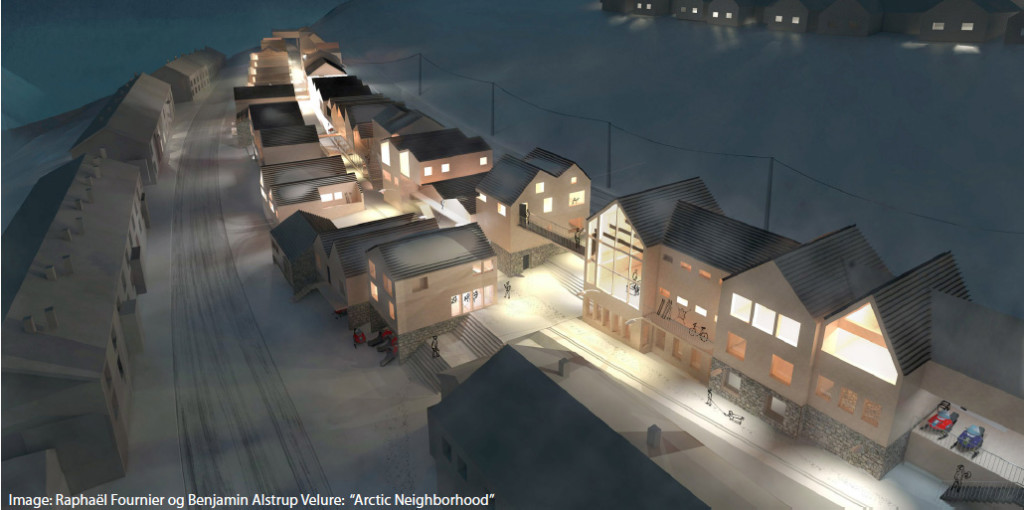The urbanity of Longyearbyen and the fluid territory of Svalbard

Research feedback: Science data and community interaction has informed our research on the future north. Through a presentation and exhibition of student work in Longyearbyen, findings and proposals are reported back to scientists and local actors in Svalbard.
In collaboration with Future North researchers, students from the Oslo School of Architecture and Design and the Tromsø Academy of Landscape and Territorial Studies have studied Longyearbyen and the territorial expanse of western Svalbard.
 SVALBARD AS A FLUID TERRITORY
SVALBARD AS A FLUID TERRITORY
This studio examined Svalbard as a fluid territory and explored different methods to map a territory. The mapping, conceived as a series of layered, interlinked chronologies, has explored quantitative (data-driven), historiographic (archive research) and qualitative (memory and oral histories) aspect of this territory. We explored the territory by foot, car and boat, which allowed us engage with the landscape in different ways and at different speeds. Each place offered very different perspectives of Svalbard as a territory. The settlements, for example, uncovered very different cultural layers but all contained industrial pasts that contrasted strongly to the outside environs that gave a sense of wildness and purity. Using section lines as the main research tool allowed for new and unforeseen readings of the territory. In addition, time was introduced to further enhance and inform the section. The superimposition of time and space revealed new logics, information and insights into Svalbard. The time frames varied enormously – from tracing Svalbard’s geologic timeframe to mapping satellite trajectories over Svalbard in a 24 hour period. The product of the studio is an archive of material rather than an atlas of territorial information. It extends beyond the fixed data that we can easily access to examine the conditions that determine why a place is the way it is. It echoes philosopher Jacques Derrida’s reference to the archive as both place and process. The studio can conclude that Svalbard is a territory in constant flux, where processes from the local to the global level, influence its being. It questions how landscape architects can develop an integral
role in the Arctic in a territory of uncertainty.
 LONGYEARBYEN
LONGYEARBYEN
The Autumn 2015 Urban Design studio at AHO explored the specific urban landscapes of Longyearbyen in the archipelago of Svalbard. This community has undergone rapid development, possibly facing even more dramatic changes in the years ahead. A main issue for many Arctic communities, as elsewhere in the world, is the development of social, economic and environmental sustainability, something that is also highly relevant in Longyearbyen. This studio has focused on a wide range of issues, not in order to separate them, but rather to capture the complexity of the everyday and site-specific, treating these issues as complementary, entangled and place-related. In our study, we have asked: what kind of urban design strategies, projects and landscape interventions will benefit Longyearbyen in order for it to become a more liveable, sustainable and enjoyable Artic city? We mapped the urban and landscape characteristics of Longyearbyen, a mapping of potentials and resources but also of challenges and needs. This mapping along with insights provided by key actors in the community, provided us with a place-specific basis of knowledge. Based on this, we collaboratively formulated positions on the future of the local society and teams of students proposed projects, strategic urban designs, and landscape interventions in and around the city. The themes of the projects include: new urban landscapes, seafront development, retail and tourism infrastructure, new housing, and social facilities. The student projects have collectively indicated themes and strategies for longterm sustainable urban development. It is the complementarity of these themes, based on wide scope knowledge collection and collaborative approaches, that first and foremost promises sustainability in the future thinking of cities in the Arctic.
Longyearbyen studio: Teachers: Peter Hemmersam and Lisbet Harboe. Students: Alberto Ballesteros Barea, Robert Blödorn, Ka Yeung Chi, Wai Fung Chu, Martin Danais, Raphaël Fournier, Veronica Gallina, Simon Heidenreich, Eakapob Huangthanapan, Alexandra Niedermayr, Minh Tin Phan, Berenice Rigal, Nadine Schmauser, Kari Tønseth, Benjamin Astrup Velure
Svalbard studio: Teachers: Janike Kampevold Larsen, Kathleen John-Alder (Rutgers University), Mats Kemppe Eimear Tynan, Riccardo Pravettoni. Students: Jérome Codère, Hans Eriksson, Brona Keenan, Charlie Laverty, Rasmus Pedersen, Matt Poot, Audrey Touchette.



